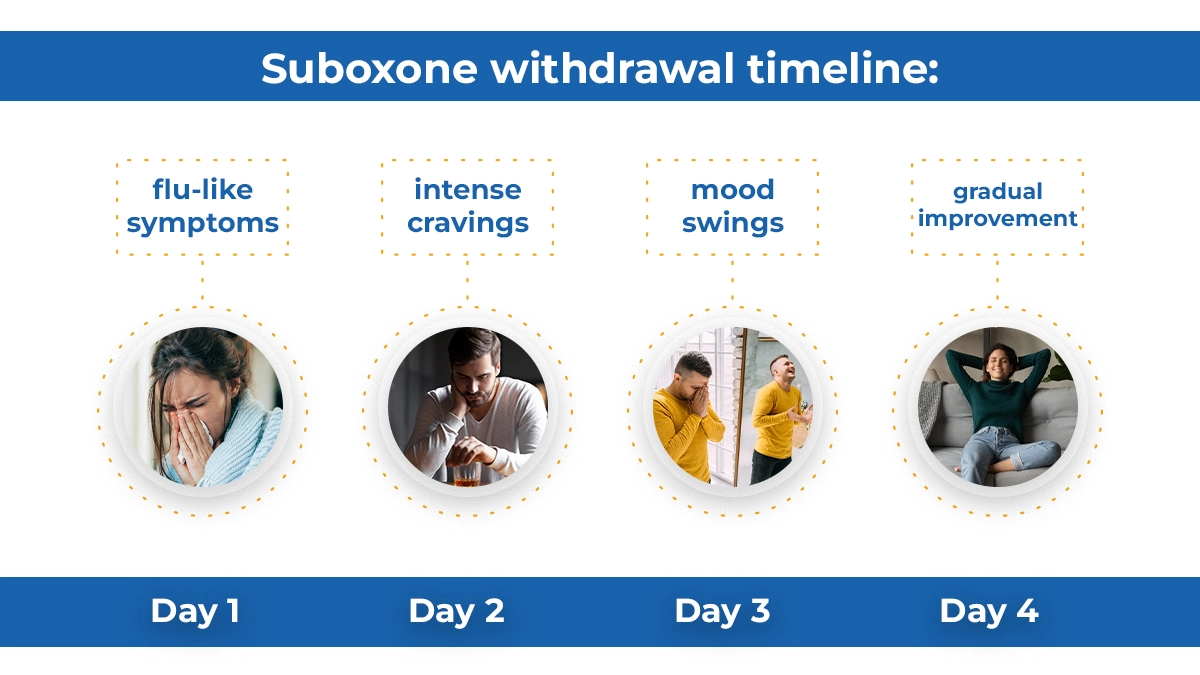Suboxone Withdrawal Timeline
Suboxone withdrawal is a challenging process that individuals may encounter when discontinuing the medication used to treat opioid dependence. As a combination of buprenorphine and naloxone, Suboxone aims to alleviate withdrawal symptoms and cravings. However, when individuals decide to cease its use, they may experience a distinct withdrawal timeline.
This timeline typically unfolds in stages, encompassing initial symptoms within the first 72 hours, followed by a peak around the one-week mark. Understanding the Suboxone withdrawal timeline is essential for both individuals seeking recovery and healthcare professionals guiding them through this challenging process.
Key Takeaways
Psychological and emotional support, along with a comprehensive treatment plan, can help navigate the challenges of Suboxone withdrawal and achieve effective recovery. Here’s what you need to know:
- Suboxone withdrawal starts around 36 hours after the last dose, peaking on days two to four.
- Suboxone withdrawal is influenced by factors such as the individual’s dosage, duration of use, and overall health, making withdrawal experiences highly variable.
- Gradual tapering with professional support helps manage Suboxone withdrawal effectively.
Contact The Recovery Team at (800) 817-1247 for personalized assistance and support for withdrawal management.
Suboxone: An Overview
Suboxone, a medication combining buprenorphine and naloxone, is prescribed to manage opioid addiction. While it helps reduce withdrawal symptoms and cravings, prolonged use may lead to dependence. Suboxone dependence can manifest through physical and psychological reliance, making discontinuation challenging.
Abrupt discontinuation or misuse of Suboxone can result in withdrawal symptoms. Withdrawal symptoms from Suboxone can vary in intensity and duration, and they may include:
Here are some common symptoms of Suboxone withdrawal:
Early Withdrawal Symptoms
- Anxiety
- Agitation
- Insomnia
- Sweating
- Runny nose
- Watery eyes
- Yawning
Peak Symptoms
- Muscle aches and pains
- Nausea and vomiting
- Diarrhea
- Abdominal cramps
- Dilated pupils
- Goosebumps (piloerection)
- Increased heart rate
Later Symptoms
- Depression
- Anxiety
- Insomnia
- Drug cravings
It’s important to note that the intensity and duration of drug use symptoms can vary depending on factors such as the individual’s physiology, the dosage of Suboxone used, and the duration of use. Abruptly stopping Suboxone can lead to a rapid onset of withdrawal symptoms.
Suboxone Withdrawal Timeline
Suboxone can be effective in managing opioid receptors and dependence; discontinuing its use may lead to withdrawal symptoms. The Suboxone withdrawal timeline varies from person to person and is influenced by factors such as dosage, duration of use, and individual physiology.
Initial Stage
The first signs of Suboxone withdrawal typically appear within 12-48 hours after the last dose. Early symptoms include anxiety, high blood pressure, irritability, muscle cramps, and cravings. These initial hours can be challenging as the body begins to adjust to the absence of the medication.
Peak Withdrawal
The withdrawal symptoms often peak around the third to fifth day. Intense cravings, nausea, vomiting, diarrhea, stomach cramps, and insomnia are common during this Stage. Physical and psychological discomfort can be overwhelming, making it a critical phase in the withdrawal process.
Subacute Withdrawal
As the initial intensity starts to subside, the subacute withdrawal stage begins. While symptoms persist, they become more manageable. Individuals may still experience lingering fatigue, mood swings, and difficulty concentrating.
Post-Acute Withdrawal
Some individuals may experience protracted withdrawal symptoms that can last for weeks or months. These severe symptoms, including anxiety, depression, and sleep disturbances, may persist but gradually diminish over time.
Factors Influencing the Withdrawal Timeline
A range of factors can influence the withdrawal timeline for various substances, and these factors can vary depending on the specific substance in question.
Here are some common factors that can influence the withdrawal timeline:
Type of Substance
Different substances have different withdrawal timelines. For example, opioids, benzodiazepines, alcohol, and stimulants may each have distinct withdrawal symptoms and durations.
Dosage and Frequency of Use
The amount and frequency with which a person uses a substance can affect withdrawal. Higher doses and more frequent use may lead to more intense withdrawal symptoms.
Individual Differences
Each person’s body and metabolism are unique. Factors such as genetics, overall health, and co-occurring medical or mental health conditions can influence how the body processes and eliminates substances, affecting the withdrawal timeline.
Method of Use
The way a substance is used can impact the withdrawal experience. For example, smoking, injecting, or snorting a substance may result in different withdrawal profiles.
Tapering Off vs. Cold Turkey
The method of discontinuation can influence the withdrawal timeline. Gradual tapering off a substance under medical supervision may result in a smoother and less intense withdrawal compared to abruptly stopping use (going “cold turkey”).
Medical and Psychological Support
Access to medical and psychological support during withdrawal can significantly impact the process. Medications, counseling, and a supportive environment can help manage symptoms and improve the overall experience.
Polydrug Use
If an individual uses multiple substances concurrently, the withdrawal timeline can be more complex. Different substances may have interacting withdrawal effects. It’s important to note that symptoms of withdrawal can be a complex and individualized experience.
Professional guidance from medical practitioners is recommended for patients going through withdrawal and psychological dependence, especially for substances with potentially severe withdrawal symptoms. Always consult with healthcare professionals for personalized advice and support for medical conditions.
Recovery and Moving Forward
Recovery is a dynamic process involving overcoming Suboxone abuse challenges and moving forward toward positive change. It encompasses physical, mental, and emotional healing, often requiring resilience and a commitment to personal growth.
Supportive therapies, counseling, and a strong social network are crucial in rebuilding life, rediscovering purpose, and adopting healthier, more effective ways to defeat.
Overcoming the physical and psychological grip of Suboxone requires commitment and self-reflection. Celebrating small victories is essential, as each day, free from dependency, is a step towards a brighter future. The path to recovery is unique for everyone, emphasizing the importance of personalized strategies and a forward-looking mindset.
Partner With The Recovery Team
Break free from the chains of Suboxone addiction with our comprehensive addiction treatment services.
Our dedicated team offers personalized residential and intensive outpatient treatment programs and provides unwavering support, guiding you through each recovery step.
Experience the healing power of our evidence-based Cognitive Behavioral Therapy (CBT) approach, which empowers you to overcome challenges, reframe negative thought patterns, and build resilient coping mechanisms.
Call us today at (800) 817-1247 to embark on a path of lasting recovery.






